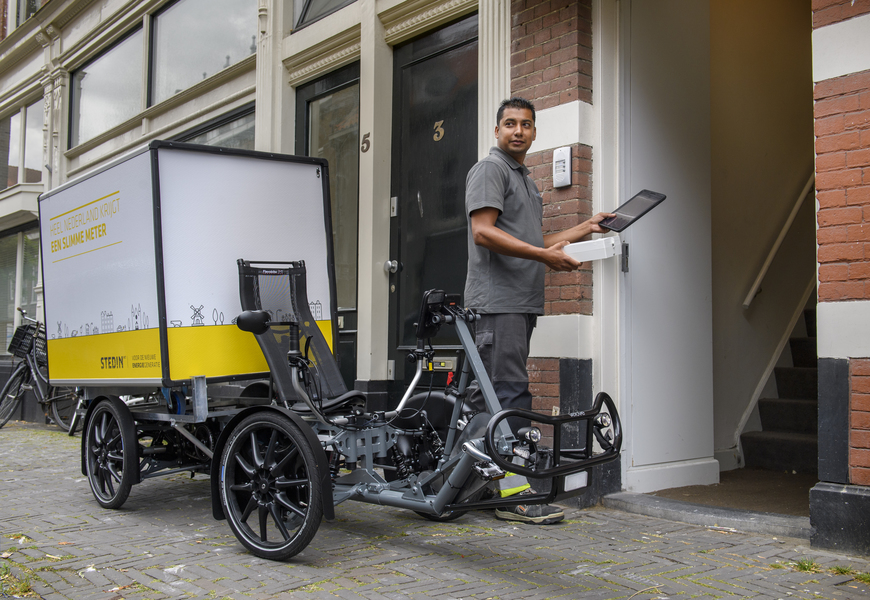Smart grids, data technology and innovation
To facilitate the energy transition, we need smart grids that give insight into the status of the grid. Together with customer demand, these data provide essential information for accurately predicting where bottlenecks may potentially arise in our grid in the future. At the same time, we are working with partners on innovative solutions that can accelerate the energy transition.
To permit smart management of our grids, we install smart sensors. These sensors enable us to carry out remote measurements and, depending on the specific sensor, perform remote switching or enable autonomous switching.
Low voltage – the smart meter
Measurements are not customarily carried out on the low-voltage grid to monitor quality and capacity. Low-voltage grid usage is changing as consumers increasingly take to generating electricity themselves. Greater insight is therefore essential. Smart meters, which have now been installed in 82.4% of households in our coverage area, are starting to play an important role in this regard. In 2021, the regional grid managers drew up a Code of Conduct governing the use of data. This states that we may use smart meters to monitor voltage quality. In low-voltage grids, capacity shortages are expressed by excessively high or low voltage. Smart meters allow us to check up to connection level whether we are complying with the voltage limits under the Grid Code. In 2021, we also began using smart meters for the purpose of failure localisation. By identifying remotely which customers are affected, we can dispatch the right technician and scale up in a timely manner.
Availability of smart meter data
New legislation means we now have to store data for 24 months. Smart meter data read-outs increased by 40% due to meter readings requested for the purpose of building a database. Previously, meter readings were only requested following an application from an energy supplier. This increase has not affected our continued ability to provide market parties with smart meter data in a secure, reliable and efficient manner. We have also made improvements to the process of on-site smart meter installation. During installation, a fitter can check straight away whether the meter is online and communicating. This new working method has resulted in a 2% decrease in meter failures following installation.
High demands are placed on the privacy and security of the smart meter infrastructure. Every two years, all the grid managers are subjected to a detailed external audit, and privacy and security are assessed for compliance with the necessary quality criteria. This audit was carried out again in 2021. Based on the audit outcomes, adjustments are made as and where necessary.
Further development of smart meters
Several generations of smart meters are due for replacement from 2025. Together with the other grid managers in the Netherlands, we determine which requirements must be met by the next generation of meters.
Milestone for smart meter installation
After six years’ work, the moment finally arrived: smart meter installation was offered to all the low-use customers in our service area, resulting in actual installation for at least 80% of them. That is a significant milestone. At the end of 2021, 82.4% of smart meters had been installed. That translates to 109,743 smart meter installations in 2021.
Total number of households in Stedin’s coverage area: 2,364,670 / with a smart meter: 1,948,419.

Offer and installation of remaining smart meters: New mandate from the Ministry of Economic Affairs and Climate Policy
A commitment to phasing out the netting scheme was part of the coalition agreement reached by the previous government. For this purpose, a bill was prepared, which was declared controversial after the fall of the coalition government. The bill for the related Act will be debated once again now that a new government has been installed. Until the Act enters into force, we have been given a new mandate by the Ministry of Economic Affairs and Climate Policy providing for the offer and installation of a smart meter in respect of 416,251 customers in our coverage area that remain without a smart meter. The absence of the Act and the related enforcement possibility by Radiocommunications Agency Netherlands mean it is more difficult to induce consumers to accept installation of a smart meter. We are in intensive discussions with the Ministry of Economic Affairs and Climate Policy to determine the impact of the delayed legislation on our organisation (people and meters).
What is the netting scheme?
Under the current scheme, customers deduct electricity returned to the grid from the electricity they purchase from the supplier. This is referred to as ‘netting off’. Consumers only pay for the net purchased electricity. The scheme aims to incentivise the installation of solar panels. The scheme is so successful that it now shows signs of over-incentivisation. To tackle this problem, the current government has chosen to phase out the scheme. The ‘Phasing Out of Netting Scheme’ legislative amendment has been submitted to the Lower House of the Dutch Parliament. The bill sets out that consumers must have a meter that measures electricity consumption as well as feed-in. Consumers are therefore no longer able to refuse a meter of this type.
Phasing out of Tone Frequency (TF) signal
On 1 July 2021, the regional grid managers stopped transmitting the Tone Frequency (TF) signals. The transmission systems that emit the TF signals are severely outdated and need replacing. There are more modern techniques we could use, including smart meters. TF signals were used by traditional electricity meters to switch between peak and off-peak rates, and they were also used to turn public lights on and off. In addition, certain electrical boilers were operated using TF signals. Stedin phased out the TF signal that is used when electricity is bought at dual rates between 1 July and 1 November 2021. Peak and off-peak rates are now no longer available without a smart meter. Stedin has informed its customers of this. Unfortunately, some of these customers were mistakenly sent the wrong letter. We corrected this error and regret that this group of customers initially received incorrect information.
Connectivity for reading out smart meters
In 2021, we installed 17,089 new smart LTE meters. While they continue to use the GPRS signal to communicate, it is expected that they will switch over to LTE communication technology in 2022. These LTE meters will replace the smart meters that use GPRS to communicate, since GPRS 2G technology is due to be phased out over the coming years. The negotiations with the telecom providers on using the GPRS network are continuing, in cooperation with other grid managers. The LTE meters are being installed at locations that have poor CDMA telecommunications network coverage. The choice of multiple communication techniques improves the quality of our data services.
The Ministry of Economic Affairs and Climate Policy plans to reallocate the 450 MHz frequency band in 2022. Stedin, Alliander and Westland Infra use this frequency band for the connection of roughly half the smart meters using CDMA technology. The Ministry intends to divide the band into two parts: one part is for grid managers for the existing CDMA meters, while the other part will be reallocated by the Ministry. This ensures the continuity of the existing CDMA meters. Stedin and Alliander are jointly preparing for this reallocation.
Medium voltage
Using available network information for the energy transition
As a system operator, we need to have up-to-date insight into the quality and capacity of the distribution network. This in light of the fact that the energy transition requires us to be able to conduct rapid assessment of our grids, so that we can take timely and targeted action to strengthen them, for instance. For that reason, we are installing smart sensors in our grids, such as the Smart Grid Terminals and, from next year, its successor, the DA box. The tendering procedure for the DA box has been completed. We will start installing the first DA boxes in 2022 before rolling them out in larger volumes in 2023.
High voltage
The key parts of transmission and distribution stations are fitted with smart equipment that protects the essential components, remotely monitors the condition of the substation and also remotely operates the substation. Each year, we carry out 15 to 20 major station automation projects.
Stedin Telecom Network
Since October 2018, Stedin has been phasing in the use of a new fibre-optic network (Stedin Telecom Network) across Stedin's entire area. This modern telecommunications network establishes a data link to all the automation systems in transmission stations and the larger medium-voltage distribution stations in our area. This improves our insight into the functioning of the energy grid and allows us to lay the foundation for smarter management and control. This network has now been fully implemented in The Hague as well as large parts of Rotterdam, Dordrecht and Utrecht. We will complete the project during 2022.
IT strategy
In 2021, we upgraded several core systems, in a significant contribution to our strategic initiatives. One measure we have taken to work as a system operator is the implementation of the ‘Forecast Manager’. This improves foresight into the energy flowing through the grid. A customer-oriented approach is easier now we record all customer information in a single system and have a clear view of the status of products and services. We also put foundations in place for a further simplification and automation of business processes and more innovative user experiences via apps. Finally, we made our IT landscape more agile by working increasingly with Application Programming Interfaces (APIs). APIs ensure that systems and applications can communicate with one another.
Data governance
To comply with the requirements for ISO 27001 certification, we implemented a new data and document classification policy. Employees followed an e-learning programme and took a test. Classification is also a standard provision in the Microsoft 365 products. This enables enhanced protection of confidential information.
To ensure that data can be found more easily, a precondition for extracting more value from them, we are investing in recording metadata. In 2021, the most important strategic and mandatory reports were incorporated in the metadata system, with the route followed by data from source system to report being recorded definitions and responsibilities were also described. This supports the owners of the reports in safeguarding the quality of their reports.

